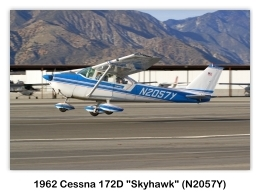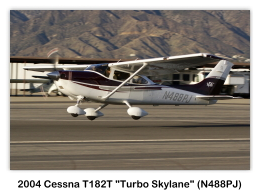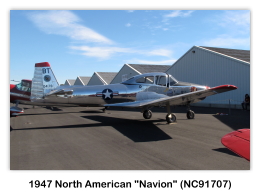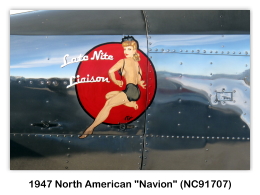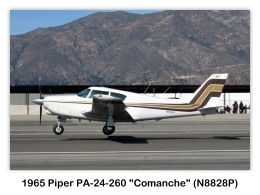


















2009 Cable Air Show — Flights of Vintage, Antique and Homebuilt Aircraft ( 4 of 5 )
11 January 2009 (Sunday Air Show)
| Previous | Next |
American Champion 8KCAB "Super Decathlon"

The 8KCAB Decathlon and Super Decathlon are two-seat fixed conventional gear light airplanes designed for flight training and personal use and capable of sustaining aerobatic stresses between +6g and -5g. The Decathlon entered production in the United States in 1970 as a more powerful and stronger complement to the Citabria line of aircraft.
American Champion 8KCAB "Super Decathlon" (N81SD, s/n 922-2003)
The Beechcraft Bonanza is an American general aviation aircraft introduced in 1947 by The Beech Aircraft Corporation of Wichita, Kansas. As of 2009 it is still being produced by Hawker Beechcraft and has been in continuous production longer than any other airplane in history. More than 17,000 Bonanzas of all variants have been built.
1979 Beech F33A "Bonanza" (N913KM, s/n CE-892)
Boeing-Stearman PT-17 "Kaydet"

The Stearman (Boeing) Model 75 is a biplane, of which at least 9,783 were built in the United States during the 1930s and 1940s as a military trainer aircraft. Stearman became a subsidiary of Boeing in 1934. Widely known as the Stearman, Boeing Stearman or Kaydet, it served as a Primary trainer for the USAAF, as a basic trainer for the USN (as the NS & N2S), and with the RCAF as the Kaydet throughout World War II. After the conflict was over, thousands of surplus aircraft were sold on the civil market. In the immediate post-war years they became popular as crop dusters and as sports planes.
Boeing-Stearman PT-17 "Kaydet" (N4432Q, s/n 75-1969)
The Cessna 120 and the Cessna 140 are single engine, two-seat, light general aviation aircraft that were first produced in 1946, immediately following the end of World War II. Production ended in 1950, and was succeeded by the Cessna 150, a similar two-seat trainer which introduced a tricycle gear. The 120 and the 140, together, sold 7,664 copies in the five years that the aircraft were produced.
1946 Cessna 140 (N76496, s/n 10926)
The Cessna 172 "Skyhawk" is a four-seat, single-engine, high-wing fixed-wing aircraft. It was first flown in 1955 and still in production, more Cessna 172s have been built than any other aircraft.
1962 Cessna 172D Skyhawk (N2057Y, s/n 17249557)
1971 Cessna 172L Skyhawk (N3886Q, s/n 17259986)
1976 Cessna 172M Skyhawk (N1352U, s/n 17267023)
The Cessna 175 Skylark is a four-seat, single-engine, high-wing airplane produced between 1958 and 1962. The Cessna 175 was designed to fill a niche between the Cessna 172 and the heavy-duty Cessna 180. The engine of the Cessna 175 was rated at 175 hp (130 kW), or 30 hp (22 kW) more than the engine of the Cessna 172. Between 1958 and 1962, a total of 2,106 were built. The basic airplane was marketed as the Cessna 175, and the plane with a package of optional equipment and a special paint scheme was marketed as the Cessna 175 "Skylark."
1959 Cessna 175 Skylark (N7688M, s/n 55988)
The Cessna 182, marketed under the name "Skylane", is a four-seat, single-engine, light airplane. It has the option of adding two child seats, installed in the baggage area. Introduced in 1956, the Cessna 182 has been produced in a number of variants, including a version with retractable landing gear, and is the second most popular Cessna model, after the Cessna 172 "Skyhawk".
1964 Cessna 182G Skylane (N2040R, s/n 18255240)
1975 Cessna 182P Skylane (N9910E, s/n 18263970)
1972 Cessna 182P Skylane (N21238, s/n 18261508)
2004 Cessna T182T Turbo Skylane (N488PJ, s/n T18208333)
The Cessna 190 and 195 Businessliner are a family of light single radial engine powered, conventional landing gear equipped, general aviation aircraft which were manufactured by Cessna between 1947 and 1954. The 195 model was also used by the United States Air Force, Air National Guard and Army as a light transport and utility aircraft under the designation LC-126A.
1949 Cessna 195 (N195SC, s/n 7402)
1959 Commonwealth CA-25 "Winjeel"

The CAC CA-25 "Winjeel" (aboriginal for young eagle) entered service with the Royal Australian Air Force in 1955 as an ab-initio to advanced trainer aircraft.
1959 Commonwealth CA-25 "Winjeel" (NX107PJ, s/n A85-429)
1968 De Havilland Canada DHC-6 "Twin Otter"

The DHC-6 Twin Otter is a 20-passenger STOL (Short Takeoff and Landing) utility aircraft developed by de Havilland Canada. The aircraft's fixed tricycle undercarriage, STOL abilities and high rate of climb have made it a successful cargo, regional passenger airliner and MEDEVAC aircraft. In addition, the Twin Otter has been popular with commercial skydiving operations.
1968 De Havilland Canada DHC-6 "Twin Otter" (N64150, s/n 150)
1940 De Havilland DH.82A "Tiger Moth"

The de Havilland DH.82 "Tiger Moth" is a 1930s biplane designed by Geoffrey de Havilland and was operated by the Royal Air Force and others as a primary trainer. The Tiger Moth remained in service with the RAF until 1952 when many of the surplus aircraft entered civil operation. Many other nations used the Tiger Moth both in military and civil applications and the ubiquitous little trainer is still in great demand worldwide as a recreational aircraft. It is still occasionally used as a primary training aircraft, although now most Tiger Moths employed in training duties are used by pilots gaining experience for "taildragger" license ratings.
1940 De Havilland DH.82A Tiger Moth (N523R, s/n 82960)
The ERCO Ercoupe is a low wing monoplane first manufactured by the Engineering and Research Corporation (or ERCO) shortly before World War II. It was designed to be the safest fixed-wing aircraft that aerospace engineering could provide at the time, and the type still enjoys a very faithful following today. In late 1931, aeronautical engineer Fred Weick was the assistant chief of the aeronautics division of the National Advisory Committee for Aeronautics (NACA). A group of co-workers and he designed and assembled an experimental aircraft in 1934 with a group of his colleagues. Responding to a Bureau of Air Commerce sponsored design competition to build an easy-to-fly, safe aircraft, Weick and his friends worked on the project in their spare time and paid for it themselves.
1946 Ercoupe 415-C (N3437H, s/n 4062)
The Lancair IV and Lancair IV-P are a family of four-seat low-wing retractable-gear composite monoplanes powered by a 550 cubic inch Continental turbo-normalised piston engine.
2002 Lancair IV-P (N111HH, s/n HHF001)
The North American SNJ "Texan" was a single-engine advanced trainer aircraft used to train fighter pilots of the United States Navy and United States Marine Corps during World War II. The North American AT-6 "Texan" / SNJ "Texan" / "Harvard" was first produced in 1939 and was similar to and eventually replaced the North American BC-1A basic combat trainer when the Basic Combat classification was abandoned. The USAAC designated it as the "AT-6", the US Navy the "SNJ", and British Commonwealth air forces, the "Harvard", the name it is best known by outside of the United States. The North American AT-6 "Texan" is known by a variety of designations depending on the model and operating air force.
North American SNJ-5 "Texan" (N7300C, BuNo 43763)
The North American "Harvard" was a single-engine advanced trainer aircraft used to train fighter pilots of the Royal Air Force and other air forces of the British Commonwealth during World War II. The North American AT-6 "Texan" / SNJ "Texan" / "Harvard" was first produced in 1939 and was similar to and eventually replaced the North American BC-1A basic combat trainer when the Basic Combat classification was abandoned. The USAAC designated it as the "AT-6", the US Navy the "SNJ", and British Commonwealth air forces, the "Harvard", the name it is best known by outside of the United States. The North American AT-6 "Texan" is known by a variety of designations depending on the model and operating air force.
North American "Harvard IIA" (N96281, s/n 3832)
The Navion is a United States single-engine, four-seat aircraft originally designed and built by North American Aviation in the 1940s. It was later built by Ryan Aeronautical Company and the Tubular Steel Corporation (TUSCO).
North American "Navion" "Late Nite Liaison" (NC91707, s/n NAV-4-178)
North American "Navion" (N91103, s/n NAV-4-5)
North American B-25J-10-NC (TB-25N) "Mitchell - Pacific Princess" (N9856C, AF 43-28204)

The North American B-25 Mitchell was an American twin-engine medium bomber manufactured by North American Aviation. It was used by many Allied air forces, in every theater of World War II, as well as many other air forces after the war ended, and saw service across four decades. The North American B-25 was named in honor of General Billy Mitchell, a pioneer of U.S. military aviation. The North American B-25 is the only American military aircraft named after a specific person. By the end of its production, nearly 10,000 B-25s in numerous models had been built. These included a few limited variations, such as the US Navy's and US Marine Corps' North American PBJ-1 patrol bomber and the Army Air Forces' North American F-10 photo reconnaissance aircraft.
North American B-25J-10-NC (TB-25N) "Mitchell — Pacific Princess" (N9856C, AF 43-28204)
North American "Texan / Harvard / Mitchell" Formations



Always a crowd pleaser at Air Shows are the "Heritage Flights". In this case a North American Texan, Harvard, and Mitchell formation made several passes. The flight was in reality a "North American Family Heritage" event.
North American SNJ-5 "Texan" / "Harvard IIA" / TB-25N "Mitchell" Formations
The Piper PA-24 "Comanche" is a four-seat, low-wing, all-metal, light aircraft of monocoque construction with retractable landing gear, The prototype Comanche first flew on 24 May 1956.
1965 Piper PA-24-260 "Comanche" (N8828P, s/n 24-4284)
Piper PA-28-180 "Cherokee 180"

First flown on January 14, 1960, the Cherokee is a low-cost four-seat all-metal low-wing monoplane with a non-retractable tricycle landing gear. Only 1,200 parts go into its "manufacture", compared with over 1,600 in the four-seat high-wing Piper Tri-Pacer, which preceded it. The first production Cherokee flew on February 10, 1961 and production reached four aircraft per day by the beginning of 1962. The 1,000th Cherokee was delivered on January 24, 1963.
1966 Piper PA-28-180 "Cherokee 180" (N9085J, s/n 28-3122)
First flown on January 14, 1960, the Cherokee is a low-cost four-seat all-metal low-wing monoplane with a non-retractable tricycle landing gear. Only 1,200 parts go into its "manufacture", compared with over 1,600 in the four-seat high-wing Piper Tri-Pacer, which preceded it. The first production Cherokee flew on February 10, 1961 and production reached four aircraft per day by the beginning of 1962. The 1,000th Cherokee was delivered on January 24, 1963.
1975 Piper PA-28-181 "Archer II" (N4410X, s/n 28-7690012)
1976 Piper PA-28-181 "Archer II" (N8788E, s/n 28-7690204)
Piper PA-28R-200 "Cherokee Arrow"

In 1967, Piper introduced the PA-28R-180 Arrow. This aircraft featured a constant-speed propeller and retractable landing gear and was powered by a 180-hp (134 kW) Lycoming IO-360-B1E engine. A 200-hp (149 kW) version powered by a Lycoming IO-360-C1C was offered as an option beginning in 1969 and designated the PA-28R-200.
1975 Piper PA-28R-200 "Arrow" (N32978, s/n 28R-7535103)
The Rutan VariEze is a composite, canard aircraft designed by Burt Rutan. It is a fairly high-performance homebuilt, hundreds of which have been constructed. The design later evolved into the Long-EZ and other, larger cabin canard aircraft. The Varieze is notable for popularizing the canard configuration and moldless composite construction for homebuilt aircraft.
1990 Rutan "Vari-Eze" (N88ED, s/n 946)
Ryan Aeronautical PT-22 "Recruit" (Model ST3KR)

The Ryan PT-22 Recruit is a military trainer aircraft that was used by the United States Army Air Corps and it successor, the United States Army Air Forces for primary pilot training. It was the first monoplane that the Army had used for primary pilot training, as all previous PT aircraft were biplanes.
1941 Ryan Aeronautical PT-22 "Recruit" (N48742, s/n 1298)
The Aermacchi SF.260 is a light aircraft marketed as an aerobatics plane and a military trainer. It was designed by Stelio Frati, originally for Aviamilano, which flew the first prototype of it (then designated F.260) on July 15, 1964. Actual production was undertaken when SIAI Marchetti purchased the design soon thereafter and continued with this firm until the company was bought by Aermacchi in 1997. The military versions are popular with smaller air forces, which can also arm it for use in the close-support role. The design is a conventional one, featuring a low wing and tricycle undercarriage, and is often praised for its sleek lines and sporty appearance. The pilot and up to two passengers (or pilot and one student in trainer versions) are accommodated under a broad, extensively glazed canopy.
1976 SIAI-Marchetti SF-260M (N26AE, s/n 230(2106))
The Glasair I, originally built as the prototype Glasair TD taildragger, is a high-performance homebuilt aircraft built of fiberglass. Created by Tom Hamilton as a fast, two-seat kitplane, the Glasair TD first flew in 1979. Hamilton formed Stoddard-Hamilton Aircraft that year to produce and market the kit, which was the first pre-molded composite aircraft available to builders.
1997 Stoddard-Hamilton (Jerry A. Hollandsworth) Glasair I GL20 (N115GL, s/n 115)
The Van's RV-6 is a two-seat, single-engine, low-wing homebuilt airplanes sold in kit form by Van's Aircraft. The RV-6 is the tail-wheel equipped version. The RV-6 was the first aircraft in the popular Vanís RV series to feature side-by-side seating and the first to offer a nosewheel option. It was first flown in 1985. Over 2000 kits have been completed and flown.
1997 Gary Sobek Vans RV-6 (N157GS, s/n 20480)
The Van's RV-6A is a two-seat, single-engine, low-wing homebuilt airplanes sold in kit form by Van's Aircraft. The RV-6A features a nose-wheel. The RV-6 was the first aircraft in the popular Vanís RV series to feature side-by-side seating and the first to offer a nosewheel option. It was first flown in 1985. Over 2000 kits have been completed and flown.
2000 Paul Rosales Vans RV-6A (N628PV, s/n 24279)
Vans RV-6 and RV-6A Formation Flight


The Van's RV-6 and RV-6A are two-seat, single-engine, low-wing homebuilt airplanes sold in kit form by Van's Aircraft. The RV-6 is the tail-wheel equipped version while the RV-6A features a nose-wheel. The RV-6 was the first aircraft in the popular Vanís RV series to feature side-by-side seating and the first to offer a nosewheel option. It was first flown in 1985. Over 2000 kits have been completed and flown.
Vans RV-6 (N157GS) and RV-6A (N628PV) Formation Flight
| Home
| Archive Subscriber Support
| Guestbook
| Contact Us
| Legal Notice
| Aviation Links
|
Copyright © 2010 Skytamer Images, Whittier, California
ALL RIGHTS RESERVED














